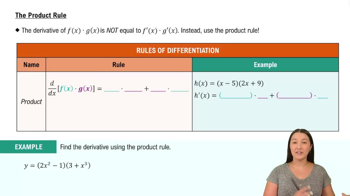Table of contents
- 0. Functions7h 52m
- Introduction to Functions16m
- Piecewise Functions10m
- Properties of Functions9m
- Common Functions1h 8m
- Transformations5m
- Combining Functions27m
- Exponent rules32m
- Exponential Functions28m
- Logarithmic Functions24m
- Properties of Logarithms34m
- Exponential & Logarithmic Equations35m
- Introduction to Trigonometric Functions38m
- Graphs of Trigonometric Functions44m
- Trigonometric Identities47m
- Inverse Trigonometric Functions48m
- 1. Limits and Continuity2h 2m
- 2. Intro to Derivatives1h 33m
- 3. Techniques of Differentiation3h 18m
- 4. Applications of Derivatives2h 38m
- 5. Graphical Applications of Derivatives6h 2m
- 6. Derivatives of Inverse, Exponential, & Logarithmic Functions2h 37m
- 7. Antiderivatives & Indefinite Integrals1h 26m
- 8. Definite Integrals4h 44m
- 9. Graphical Applications of Integrals2h 27m
- 10. Physics Applications of Integrals 2h 22m
6. Derivatives of Inverse, Exponential, & Logarithmic Functions
Derivatives of Inverse Trigonometric Functions
Problem 25
Textbook Question
Evaluate the derivative of the following functions.
f(x) = x2 + 2x3 cot-1 x - ln (1 + x2)
 Verified step by step guidance
Verified step by step guidance1
To find the derivative of the function f(x) = x^2 + 2x^3 * cot^(-1)(x) - ln(1 + x^2), we will apply the rules of differentiation to each term separately.
Start with the first term, x^2. The derivative of x^2 with respect to x is 2x, using the power rule.
Next, consider the term 2x^3 * cot^(-1)(x). This is a product of two functions, so we will use the product rule: if u(x) = 2x^3 and v(x) = cot^(-1)(x), then the derivative is u'(x)v(x) + u(x)v'(x). Calculate u'(x) = 6x^2 and v'(x) = -1/(1 + x^2).
For the term -ln(1 + x^2), use the chain rule. The derivative of ln(u) is 1/u * du/dx. Here, u = 1 + x^2, so du/dx = 2x. Therefore, the derivative is -1/(1 + x^2) * 2x.
Combine the derivatives of each term to find the derivative of the entire function: f'(x) = 2x + (6x^2 * cot^(-1)(x) + 2x^3 * (-1/(1 + x^2))) - (2x/(1 + x^2)).
 Verified video answer for a similar problem:
Verified video answer for a similar problem:This video solution was recommended by our tutors as helpful for the problem above
Video duration:
4mPlay a video:
Was this helpful?
Key Concepts
Here are the essential concepts you must grasp in order to answer the question correctly.
Derivative
The derivative of a function measures how the function's output value changes as its input value changes. It is defined as the limit of the average rate of change of the function over an interval as the interval approaches zero. Derivatives are fundamental in calculus for understanding rates of change and are denoted as f'(x) or df/dx.
Recommended video:

Derivatives
Product and Chain Rules
The product rule and chain rule are essential techniques for finding derivatives of more complex functions. The product rule states that the derivative of a product of two functions is the first function times the derivative of the second plus the second function times the derivative of the first. The chain rule is used when differentiating composite functions, stating that the derivative of f(g(x)) is f'(g(x)) * g'(x).
Recommended video:

The Product Rule
Logarithmic Differentiation
Logarithmic differentiation is a technique used to differentiate functions that are products or quotients of variables raised to powers. By taking the natural logarithm of both sides of the equation, it simplifies the differentiation process, especially when dealing with products or powers. This method is particularly useful for functions involving logarithms, as seen in the given function with ln(1 + x²).
Recommended video:

Logarithmic Differentiation

 7:26m
7:26mWatch next
Master Derivatives of Inverse Sine & Inverse Cosine with a bite sized video explanation from Callie
Start learning



